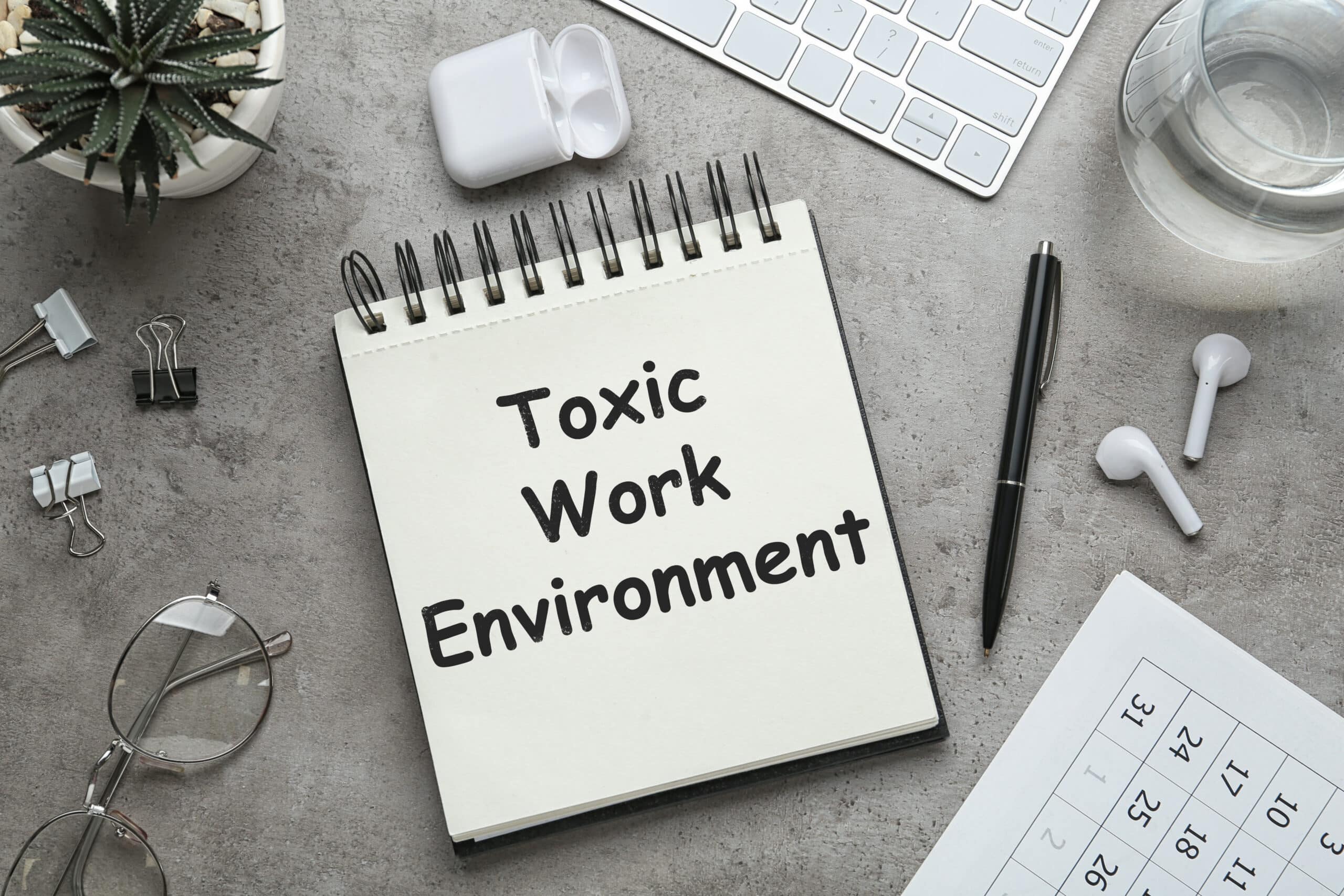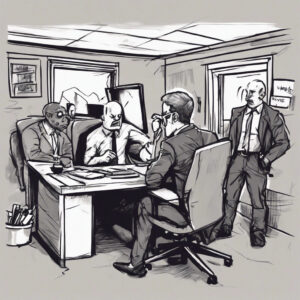
In today’s competitive work environment, we often encounter a toxic workplace. This can have a detrimental impact on your mental health and overall job satisfaction. In this hostile work environment, you must recognize coworker behaviors that hurt your success and career. You can succeed and lead if you know how to respond. You can do more than survive; you can defeat those co-workers who constantly maneuver and manipulate. It’s essential to be aware of the signs of a toxic workplace and navigate the competitive atmosphere with integrity. If you are running an office or team, your management style could be the root of the problem. This article will discuss survival and success in a competitive or toxic workplace. I’ll help you identify the signs of a toxic work culture, understand the dangers of being “typecast” by team members, and the role of leadership in fostering a positive environment.
Navigating a toxic workplace can sometimes feel like walking through a minefield. Critical indicators of such a culture include consistently high turnover rates. This can signal dissatisfaction and a lack of stability within the organization. Reports of sexual harassment indicate no standards of professionalism or decency. Additionally, unfair treatment of employees, often manifesting through favoritism or discrimination, can erode trust and morale. Emotional distress among team members is another glaring red flag. This could stem from excessive workloads, unrealistic expectations, or a pervasive atmosphere of fear and intimidation. Finally, a “lack of professional development opportunities” is a top result when American workers are surveyed.
 A hostile work environment harbors undercurrents of office gossip and verbal abuse, which can be overt or subtle. Such behaviors undermine team cohesion and contribute to a hostile work atmosphere.
A hostile work environment harbors undercurrents of office gossip and verbal abuse, which can be overt or subtle. Such behaviors undermine team cohesion and contribute to a hostile work atmosphere.
NOTE: The “covert toxic employee” is a master at subtly undermining management decisions while taking advantage and even gas lighting their collegial peers. This is not simply a “competitive coworker” or team member. This is someone prone to unethical behavior and workplace harassment when management is not around. They must face negative, well-documented consequences for this behavior before you will likely have to terminate their employment.
A lack of mutual respect is palpable in a toxic workplace, where interactions are frequently marked by dismissiveness, ridicule, or condescension. Recognition of these signs is the first step towards shielding oneself from the negative impacts. It’s imperative to remain vigilant and aware, noting how interactions, management practices, and the overall workplace climate align with these toxic traits. By identifying these early warning signs, employees and managers can better strategize on navigating the challenges ahead, advocating for a healthier work environment, or, when necessary, making the tough decision to transition away from a detrimental situation. Rememeber can always meet with Human Resources or seek Legal Advice, under the protection of the Equal Employment Opportunity Commission. Whatever you decide, knowing what constitutes a toxic work culture is fundamental in making informed decisions for one’s professional well-being.
Falling victim to typecasting by your team members can subtly yet significantly disrupt your career trajectory and tarnish your professional image. This form of labeling, often cloaked in backhanded compliments, can distort management’s perception of your skills and work ethic. For example, when colleagues remark you are “so hardworking,” it could imply an underlying message of being overzealous or not smart enough to work efficiently. Similarly, comments labeling you as “laid back” might be a euphemism for laziness in the eyes of your superiors. Sadly, when management acknowledges these slants against your true skills and ability, it is tempting to respond by doing the same to others.
Such misleading categorizations can pigeonhole you into roles that don’t align with your ambitions or capabilities. It’s crucial to recognize these dynamics and actively counteract them. The best way is to engage in open dialogues with your superiors to clarify your goals, strengths, and areas for improvement. Demonstrating your accomplishments and proactively seeking feedback can help dispel misconceptions and illustrate your value to the team. Make sure these conversations with superiors are focused on the results you deliver, not simply your behaviors or activities.
Navigating away from the negative implications of being typecast requires a conscious effort to showcase your versatility and willingness to take on varied challenges. Offering to lead projects outside your usual scope or volunteering for cross-functional teams is evidence of your breadth and depth. It will challenge one-dimensional views held by colleagues or management.
You can respond directly when someone hands you one of these backhanded compliments that are a jab at your ability. Sometimes, a toxic workplace needs a direct shake to elicit change. If you’re at a point where you need to stop an offender in their tracks, simply ask, “What do you mean, exactly?” For example, laugh a little and ask, “Linda, when you say I’m so laid back, what does that mean? You’re not implying I don’t enjoy working hard, are you? Because I work harder than just about anyone here.” That statement will put “Linda” on tilt, and she will publicly agree with you.
Understand the nuances of workplace dynamics and manage how you are perceived. Take control of the narrative. You have the power to define your professional identity. Ensure your contributions and potential are recognized and rewarded.
In a landscape marked by fierce competition, maintaining integrity is commendable; it’s essential. The journey begins with a steadfast commitment to one’s core values, steering clear of the pitfalls of negative workplace dynamics or unhealthy competition. Embrace a mindset that prioritizes ethical behavior over short-term gains. Engage in constructive competition, where success is measured not at the expense of others but through personal excellence and mutual upliftment.
The essence of integrity in a competitive setting is to model the behavior you wish to see in the workplace. This involves recognizing the contributions of others and offering support to colleagues in need. Managers must provide an atmosphere of camaraderie and respect and always highlight good ideas. When someone on the team succeeds, the best managers highlight and reward that person. Also, transparent communication is vital. Ensure your intentions and actions are clear and align with the highest ethical standards. When faced with challenges, opt for fair solutions and consider the well-being of all parties involved.
It is equally important to establish boundaries that protect your integrity. Stand firm in your principles when confronted with unethical practices or undue pressure. Diplomatically but resolutely address such issues, whether through direct conversation or by seeking guidance from leadership. This safeguards your moral compass and signals to others the value of integrity in shaping a positive and productive work environment. If you have EXCUSES, you won't after reading this excellent book by Glenn Stearns. Give it a start and let me know how it helps you!
Always navigate a competitive atmosphere with integrity. Your unwavering commitment to ethics and professionalism will demonstrate your ability to lead and inspire positive change. An open culture of respect in the workplace is not only pleasant and rewarding, but it is also more productive, and the results will be recognized by senior management.
Leaders and managers are responsible for shaping an environment where respect, collaboration, and positivity flourish in a competitive and potentially toxic workplace. A leader’s effectiveness is often measured by their ability to identify and mitigate behaviors that contribute to toxicity preemptively. This requires a keen eye for the subtleties of team dynamics and a proactive approach to conflict resolution. Leaders must cultivate an environment that discourages detrimental behaviors and encourages open communication and transparency.
Training and equipping managers with the tools to recognize and address toxic behavior is essential. This involves creating accessible and anonymous feedback avenues, allowing team members to voice concerns without fear of retribution. Leaders should also champion the importance of mental health, recognizing that a supportive work culture is foundational to employee well-being. Offensive conduct and destructive behavior can never be tolerated. Well-trained managers and employees will likely promptly recognize, address, or report these behaviors.
Moreover, leadership should exemplify the values they wish to see within the organization. This includes leading by example in fostering an inclusive culture where diversity of thought and background is celebrated rather than suppressed. Always demonstrate empathy, fairness, and integrity. Leaders set a standard for behavior that resonates throughout the team. Make your decisions based on common sense rather than bureaucratic pressures from different levels of management. The original "Situational Leader" was published in 1984. This 2023 update should be MANDATORY reading for any manager or leader.
Finally, commit to crafting a positive, ongoing environment that reflects the organization’s policies and practices. If you are a senior leader, you must train managers and employees on professional conduct, create channels for mentorship, and recognize employees who contribute positively to the company culture. Consistent, steadfast leaders transform the challenges of a competitive atmosphere into a catalyst for building a resilient and supportive work environment.
Mutual respect forms the cornerstone of a thriving work environment. It lays the foundation for healthy professional relationships and a cohesive team dynamic. In spaces where respect is consistently practiced, employees experience higher job satisfaction, enhanced collaboration, and significantly reduced conflict. This environment encourages open and honest communication, allowing team members to voice their ideas and concerns without fear of dismissal or ridicule.
Leaders play a crucial role in embedding mutual respect into the company’s culture. They must actively demonstrate respectful behavior in every interaction, setting a clear standard for all employees. This includes acknowledging the contributions of each team member, providing constructive feedback, and addressing any disrespectful behavior immediately and effectively.
Respect extends beyond direct interactions to encompass the appreciation of diverse perspectives and backgrounds. Encouraging a culture where differences are tolerated and valued fosters innovation and enriches problem-solving processes. Teams operating in mutual respect are more adept at navigating challenges as they leverage their collective expertise and experiences. This goes the same for vulnerability. Creativity and ideas die when team members are uncomfortable being vulnerable to share outside-the-box thinking or ideas without ridicule or retribution from the rest of the group. Maxwell's guide to identifying THE qualities of a team player will help you identify your "go-to" team members...and maybe your "go-to" areas of deveolpment.
Moreover, respect is not a one-way street; it requires active participation from everyone within the organization. Employees must take responsibility for their actions and words, ensuring they contribute positively to the work environment. By prioritizing mutual respect, companies can cultivate a workplace that achieves outstanding results and supports the well-being and growth of every individual.
Navigating the landscape of workplace relationships requires a delicate balance between maintaining professional boundaries and fostering genuine connections with colleagues. The art of professional social interaction is a pivotal skill in creating a productive but also supportive and engaging environment. It starts with the fundamental principle of respect—recognizing and valuing the contributions of others, irrespective of their role or status within the company.
Effective communication is at the heart of professional social interactions. This involves active listening, clear expression of ideas, and reasonable feedback sharing. Such interactions should be characterized by empathy and openness, which can significantly enhance team collaboration and trust. It’s crucial to be mindful of the impact of our words and actions on our colleagues, striving always to contribute positively to the collective atmosphere.
Dale Carnegie's timeless masterpiece is a gift for any student or professional. Grab this paperback, read it, and apply it.
A key aspect of professional social interactions is navigating differences and disagreements with tact and diplomacy. Challenges and conflicts are inevitable in any workplace; however, constructively addressing conflict can lead to innovative solutions and stronger relationships. This skill is especially important in a competitive or toxic work environment, where fostering a culture of understanding and respect can counterbalance underlying tensions.
Encouraging inclusivity through social interactions can also break down barriers and promote a sense of belonging among team members. Celebrating diversity is always the goal, but at a minimum, your team must tolerate diversity and different ideas. Seek input from all team members and engage in inclusive, fun activities. This can strengthen bonds and enrich the workplace culture. Fostering trust amongst your team must be your priority. As a manager or leader, you can never be perceived as part of a distinct group in the workplace. End these dynamics with direct communication. Tell members of these groups of their unintended consequences and sternly encourage them to be more inclusive. Root this kind of behavior out quickly and quietly.
Professional social interactions are a cornerstone of building a resilient and vibrant work community. By prioritizing these interactions, individuals can contribute to a workplace where everyone feels valued, heard, and motivated to achieve their best.
Navigating the demanding landscape of a high-pressure job requires a deliberate approach to maintaining mental health. The relentless pace and expectations can take a toll, making implementing self-care and stress management strategies imperative. Establishing boundaries between work and personal life is a critical first step, allowing for necessary downtime and recovery. Work-life balance is important.
NOTE: Beware of the term “work-life BLEND.” This new era term replaces work-life balance and is an excuse to ask more of employees during their personl time. This “blend” trend can be destructive and a sure way to receive a complaint through HR.
Engaging in regular physical activity, pursuing hobbies, and ensuring adequate rest are practical measures that support mental well-being. Additionally, cultivating a support network within and outside the workplace provides a safety net, offering perspective and assistance when challenges arise. Open communication with supervisors about workload and stress levels can lead to adjustments that make expectations more manageable. In environments where the pressure is relentless, consider accessing employee assistance programs (EAPs) if available or seek professional counseling to develop coping strategies tailored to your situation. Proactive management of mental health sustains personal well-being and enhances overall job performance, turning the pressure of a high-stakes environment into a platform for demonstrating resilience and capability.
Every hurdle presents a unique chance to strengthen your professional character and expand your skill set in a competitive or toxic workplace. These challenges, while daunting, are opportunities in disguise for demonstrating resilience, enhancing your problem-solving abilities, and refining your negotiation skills. Adopting a proactive stance towards obstacles opens the door to unparalleled personal development and the potential to stand out as a leader among your peers. Cultivate the habit of viewing each difficulty as a stepping stone, using it as leverage to propel yourself forward in your career. Embrace the learning curve of navigating a complex work environment, as it equips you with the versatility and adaptability highly sought after in today’s dynamic job market. Let every challenge fuel your ambition to emerge more robust, more skilled, and ready to seize the next opportunity for growth that comes your way.